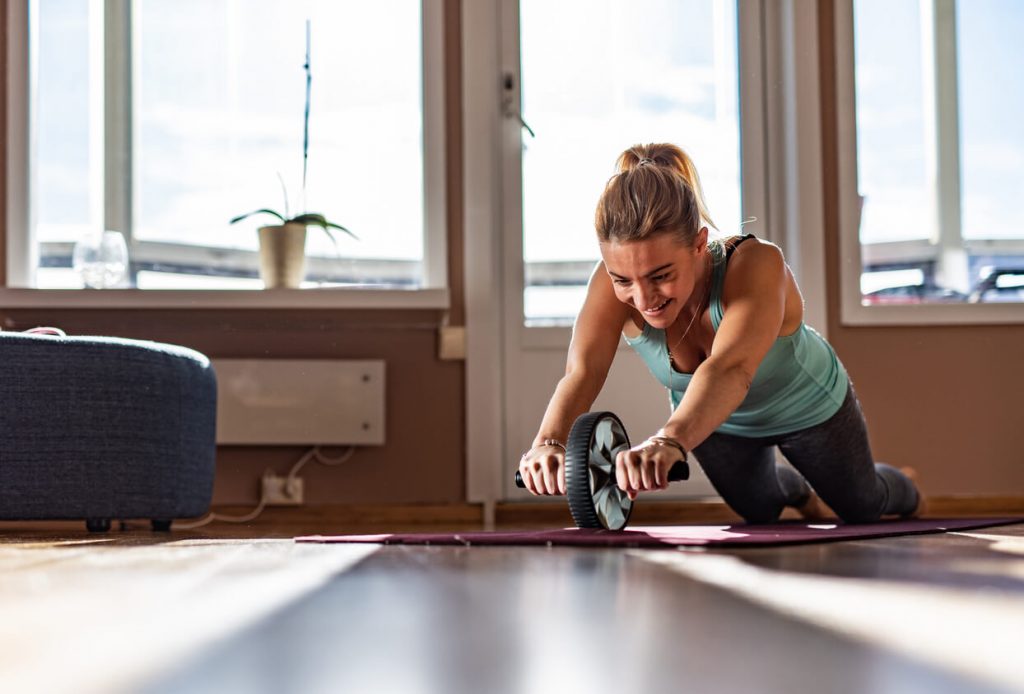7 universal fitness myths (debunked)

Fitness training has been around since 2,000 B.C., so it’s no wonder
that there are so many fitness myths floating around.
This has only escalated with the rise of social
media, where so-called ‘fitness experts’ gatekeep certain truths from their
followers to appear more knowledgeable in their field.
We spoke to qualified Personal Trainer and Pilates instructor Stephanie Morgan Todd to debunk the most common fitness myths, so you can get the facts straight and focus on what matters in your training.
1. The more pain, the better the workout
This is one of the most common fitness myths, as the
media has encouraged gymgoers to push themselves to their limits for
decades.
Films use this for dramatic effect, and the fitness
industry has been known to spread this belief so that people will blame
themselves for lacking consistency and buy into new fads and trends. Todd
says:
“Pain or delayed onset muscle soreness (DOMS) after exercise happens for two reasons:
you haven’t exercised in a while, or you’ve exercised in a new wayyou’ve completed an exercise where the eccentric movement was prolonged or emphasised—for example, a Romanian deadlift (you take more time on the way down)
Does it mean your workout wasn’t good if you don’t
feel pain afterwards? Not at all. Firstly, every workout is good. Secondly, it
depends on your goals.
If you’re working out for strength or muscle
building, ensure your sessions are progressive and intense, and you can’t go
wrong. Remember that being in pain is a good sign you’re not recovered—it’s
here that we risk injuries and mental fatigue.
Always listen to your body. The bottom line is that NOT being in pain after workouts is a good thing, and pain has no effect on muscle growth.”
2. Muscle growth can only be achieved with heavy weights
If this is true, why do so many dancers, runners,
and yogis have lean physiques?
That’s the quickest way to debunk this fitness myth,
but Todd gives us a more technical explanation:
“Muscle growth will happen when you train
progressively and with intensity. Progression is triggered by many factors,
such as using a full range of movement, perfecting form, decreasing rest time,
and increasing volume, reps, and sets. Increasing weight is just one of them.
Muscle magic will happen if you progress each body
part week-on-week (don’t forget your de-load), eat in a surplus, and push
yourself with your big compound lifts.
If your version of pushing yourself is 25 reps of a bodyweight squat rather than one rep of a 100kg weighted squat, you can still build muscle.”
3. Your muscle will turn to fat if you stop exercising
We’ve all heard this fitness myth, but here’s Todd’s
advice to those wondering if it’s true:
“Absolutely not. Fat is stored by your body when you
eat surplus calories and shrinks when you create a deficit to target those
stores. The same happens with muscle.
Muscle degeneration increases as we age, so it’s
important to exercise and eat enough protein to retain your muscle mass.
I recommend strength training for any age,
especially the older generation and those experiencing menopause. But I can
assure you that any muscle you are lucky enough to build will not turn into
fat. It will only decrease if you stop exercising for an extended period.
If you eat in a surplus and don’t lift weights,
you’re likely to build fat.”
Related: The 10 most Googled fitness questions, with expert answers
4. Ab workouts lead to a flat stomach

It would be great if this common fitness myth were
true, but you can’t target individual areas of your body. Compound exercises and
a balanced diet are the most effective for improving overall body
composition.
Todd explains:
“How often have you seen a fitness model or
influencer say, want a toned tummy or flat abs?
Do this core exercise!
What I would take away from this advice is that
they’re providing nothing more than a new core exercise to try alongside a
well-rounded exercise programme. Flat stomachs only occur when you become lean
through good nutrition.
Does it help to perform core exercises? I’d never
say no to doing more exercise, and by all means, focus on building strength in
your core, as the stronger it is, the better.
But even if you did a thousand crunches a day, you’d
still need to diet gradually within a healthy calorie deficit for your abs to
show.
Don’t get sucked into misleading ab workout videos—instead, get yourself a strong core through doing compound exercises and gradually improving your nutrition.”
5. You can target individual areas of the body for fat loss or ‘tone’
As we said above, targeting one area of your body in
isolation for fat loss is impossible. This is due to several factors, according
to Todd:
“Fat is distributed where your body desires. It’s
down to your genetic blueprint, and you cannot lose fat on only your stomach,
thighs, or any other targeted area.
You can build or lose muscle in specific areas, of
course, but you cannot “sculpt” muscle.
For example, if you did bicep curls on one arm and
not the other for an extended period, you would likely see a slight difference
in size, but you cannot change the shape of your muscles.
Lifting weights will help you achieve a leaner physique and add more definition to your body if executed correctly. Muscles grow alongside a high protein intake and progressive overload, so incorporate this into your training if you’d like to hit these goals alongside fat loss.”
6. Longer and more frequent workouts are the most effective

As far as common fitness myths go, this one is among
the most widely believed.
The NHS weekly
exercise guidelines state that 75 minutes of vigorous exercise per week is as
effective as 150 minutes of moderate exercise, however, which is a strong argument
for why it isn’t true. Todd backs this view:
“I never exercise for more than 45 minutes unless
I’m really taking time between sets and heavy lifting.
Sometimes, I think we are a little obsessed with
thinking we’ve not done enough and that this mentality holds us back from
keeping consistent and reaching our goals.
If you have a day when you’re motivated to spend
over an hour in the gym, that’s great. But what happens when you’re feeling
unmotivated, mentally fatigued and dreading being in the gym for an hour?
You can avoid this by keeping your workouts short
and intense. Some intensity and a good structure are more than enough and often
much more sustainable over time.
Exhausting yourself will eventually catch up with
you and your nervous system. Remember—we exercise for good health, not to
punish ourselves.”
Related: The importance of warming up, according to experts
7. Cutting out all junk food is the only way to lose weight
Our final fitness myth is the one we’re the most
relieved to see on this list. Todd says:
“Do you know how many times I’ve heard this?
If you’re all or nothing, chances are you’re
familiar with yo-yo dieting. But it doesn’t have to be that way—learning and
changing your approach is all it takes to break the cycle.
I believe calorie counting is the single best
education in food and diet. I cannot tell you how many people have told me, “I
don’t eat a lot”, before realising just how easy it is to overeat after a few
weeks of tracking their calories.
There is no need to never eat a couple of biscuits,
just as there is no need to eat an entire packet.
If you cut out “junk” or treats altogether, you
simply admit that you’re willing to put your weight back on.
Once you understand calories, you are educated for
life. Who wouldn’t rather that than a fad diet that destroys your relationship
with food?”
So, there we have it. The most common fitness myths
debunked by a true fitness expert, so you have a strong starting point if
you’ve been feeling lost on your fitness journey.
Thanks to Stephanie for her insights!
Specialist sports insurance through Insure4Sport
Whether
you’re a gym member,
an athlete,
or part of a competitive sports team,
you may want to protect yourself through specialist sports insurance.
Unfortunately,
most sports and physical activities come with the risk of suffering an injury.
This could not only pause your training but also affect your ability to work
and earn a living for a period.
At
Insure4Sport, you can opt for Personal Accident and Loss of Earnings cover to
help with unexpected costs and give you peace of mind in the worst-case
scenarios.
Learn more about how we can help here, or click the button below to get an instant online quote.







